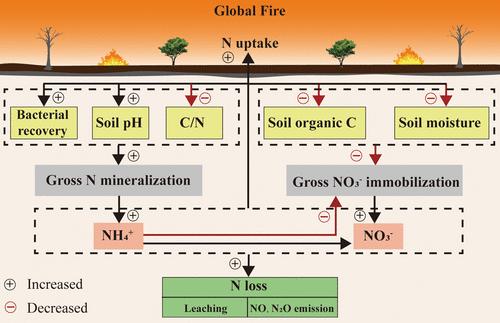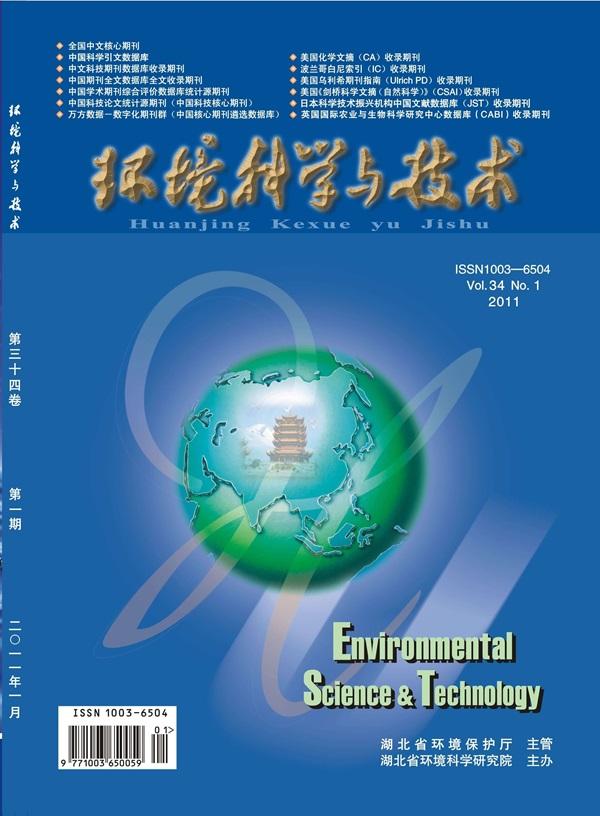火灾减少了土壤中硝酸盐的保留量,同时增加了全球土壤中氮的产生量和流失量
IF 11.3
1区 环境科学与生态学
Q1 ENGINEERING, ENVIRONMENTAL
引用次数: 0
摘要
阐明土壤总氮(N)转化对火灾的响应可以提高我们对火灾如何影响N有效性和损失的理解。然而,在全球范围内,土壤总氮转化率如何对火灾做出反应仍未得到探索。在这里,我们研究了土壤总氮对火灾的一般响应及其对氮有效性和损失的影响。结果表明:火灾增加了总氮矿化速率(GNM);+38%)和铵态氮浓度(+47%)降低,但微生物硝态氮固定化(INO3;−56%),导致氧化亚氮(N2O;+50%)、一氧化氮(+121%)排放和氮淋溶(+308%)。火灾发生时间影响土壤氮素循环和流失。火灾增加了GNM、铵态氮浓度和N2O排放量,降低了INO3,但火灾发生时间小于1年时,短期(<; 1年)和长期(>; 1年)的N浸出都有所增加。因此,火灾的后果是氮有效性和N2O排放量的短暂增加(持续不到一年),但随着时间的推移,氮的淋失风险持续存在。总的来说,火灾通过刺激氮素生产和抑制硝酸盐滞留增加了氮素损失的潜在风险。本文章由计算机程序翻译,如有差异,请以英文原文为准。

Fire Reduces Soil Nitrate Retention While Increasing Soil Nitrogen Production and Loss Globally
Elucidating the response of soil gross nitrogen (N) transformations to fires could improve our understanding of how fire affects N availability and loss. Yet, how internal soil gross N transformation rates respond to fires remains unexplored globally. Here, we investigate the general response of gross soil N transformations to fire and its consequences for N availability and loss. The results showed that fire increased gross N mineralization rate (GNM; +38%) and ammonium concentration (+47%) as a result of decreased soil C/N ratio but decreased microbial nitrate immobilization (INO3; −56%), resulting in increased nitrous oxide (N2O; +50%) and nitric oxide (+121%) emissions and N leaching (+308%). Time since fire affected soil N cycling and loss. Fire increased GNM, ammonium concentration, and N2O emission, and decreased INO3 only when time since fire was less than one year, while increased N leaching in the short (<one year) and long (>one year) terms. Thus, the consequences of fire were a short-lived increase in N availability and N2O emissions (lasting less than one year) but with persistent risks of N loss by leaching over time. Overall, fire increased the potential risks of N loss by stimulating N production and inhibiting nitrate retention.
求助全文
通过发布文献求助,成功后即可免费获取论文全文。
去求助
来源期刊

环境科学与技术
环境科学-工程:环境
CiteScore
17.50
自引率
9.60%
发文量
12359
审稿时长
2.8 months
期刊介绍:
Environmental Science & Technology (ES&T) is a co-sponsored academic and technical magazine by the Hubei Provincial Environmental Protection Bureau and the Hubei Provincial Academy of Environmental Sciences.
Environmental Science & Technology (ES&T) holds the status of Chinese core journals, scientific papers source journals of China, Chinese Science Citation Database source journals, and Chinese Academic Journal Comprehensive Evaluation Database source journals. This publication focuses on the academic field of environmental protection, featuring articles related to environmental protection and technical advancements.
 求助内容:
求助内容: 应助结果提醒方式:
应助结果提醒方式:


